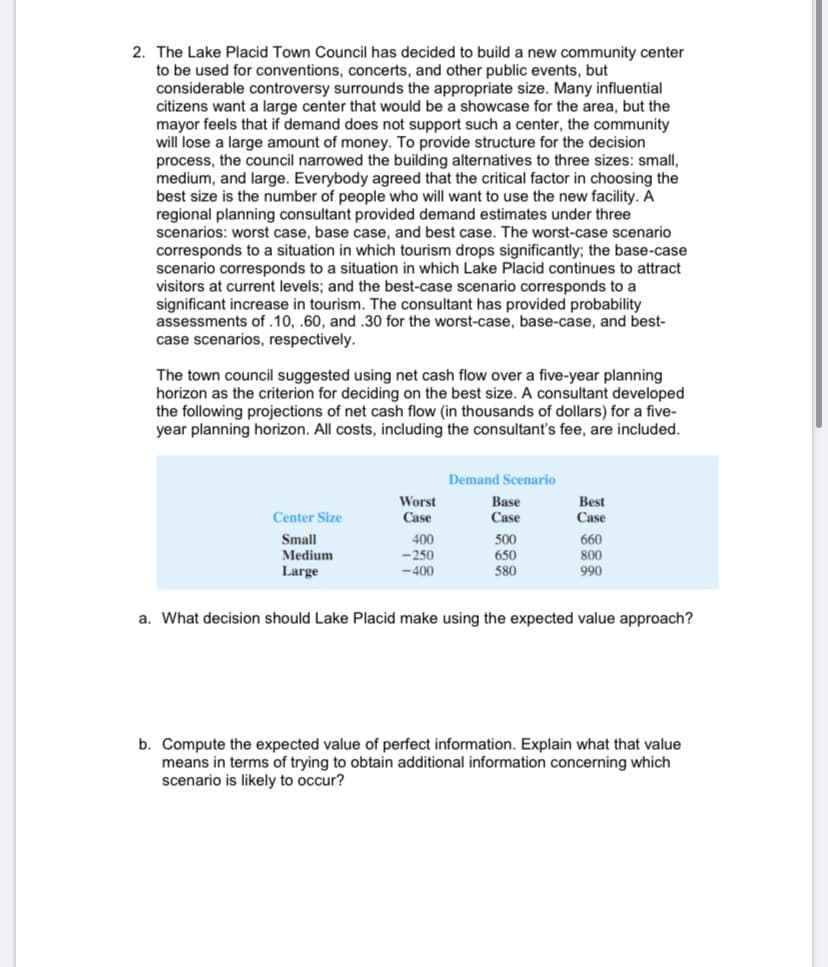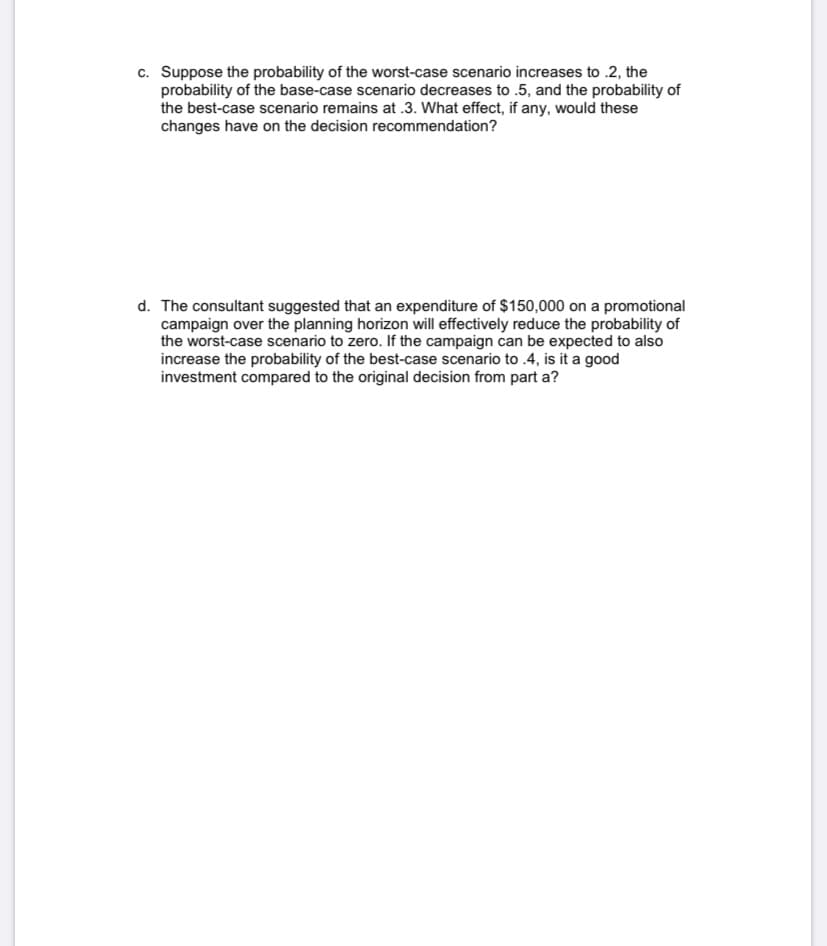2. The Lake Placid Town Council has decided to build a new community center to be used for conventions, concerts, and other public events, but considerable controversy surrounds the appropriate size. Many influential citizens want a large center that would be a showcase for the area, but the mayor feels that if demand does not support such a center, the community will lose a large amount of money. To provide structure for the decision process, the council narrowed the building alternatives to three sizes: small, medium, and large. Everybody agreed that the critical factor in choosing the best size is the number of people who will want to use the new facility. A regional planning consultant provided demand estimates under three scenarios: worst case, base case, and best case. The worst-case scenario corresponds to a situation in which tourism drops significantly; the base-case scenario corresponds to a situation in which Lake Placid continues to attract visitors at current levels; and the best-case scenario corresponds to a significant increase in tourism. The consultant has provided probability assessments of .10, .60, and .30 for the worst-case, base-case, and best- case scenarios, respectively. The town council suggested using net cash flow over a five-year planning horizon as the criterion for deciding on the best size. A consultant developed the following projections of net cash flow (in thousands of dollars) for a five- year planning horizon. All costs, including the consultant's fee, are included. Demand Scenario Worst Case Base Case Best Case Center Size Small 400 -250 -400 500 650 660 800 990 Medium Large 580 a. What decision should Lake Placid make using the expected value approach?
2. The Lake Placid Town Council has decided to build a new community center to be used for conventions, concerts, and other public events, but considerable controversy surrounds the appropriate size. Many influential citizens want a large center that would be a showcase for the area, but the mayor feels that if demand does not support such a center, the community will lose a large amount of money. To provide structure for the decision process, the council narrowed the building alternatives to three sizes: small, medium, and large. Everybody agreed that the critical factor in choosing the best size is the number of people who will want to use the new facility. A regional planning consultant provided demand estimates under three scenarios: worst case, base case, and best case. The worst-case scenario corresponds to a situation in which tourism drops significantly; the base-case scenario corresponds to a situation in which Lake Placid continues to attract visitors at current levels; and the best-case scenario corresponds to a significant increase in tourism. The consultant has provided probability assessments of .10, .60, and .30 for the worst-case, base-case, and best- case scenarios, respectively. The town council suggested using net cash flow over a five-year planning horizon as the criterion for deciding on the best size. A consultant developed the following projections of net cash flow (in thousands of dollars) for a five- year planning horizon. All costs, including the consultant's fee, are included. Demand Scenario Worst Case Base Case Best Case Center Size Small 400 -250 -400 500 650 660 800 990 Medium Large 580 a. What decision should Lake Placid make using the expected value approach?
MATLAB: An Introduction with Applications
6th Edition
ISBN:9781119256830
Author:Amos Gilat
Publisher:Amos Gilat
Chapter1: Starting With Matlab
Section: Chapter Questions
Problem 1P
Related questions
Question

Transcribed Image Text:2. The Lake Placid Town Council has decided to build a new community center
to be used for conventions, concerts, and other public events, but
considerable controversy surrounds the appropriate size. Many influential
citizens want a large center that would be a showcase for the area, but the
mayor feels that if demand does not support such a center, the community
will lose a large amount of money. To provide structure for the decision
process, the council narrowed the building alternatives to three sizes: small,
medium, and large. Everybody agreed that the critical factor in choosing the
best size is the number of people who will want to use the new facility. A
regional planning consultant provided demand estimates under three
scenarios: worst case, base case, and best case. The worst-case scenario
corresponds to a situation in which tourism drops significantly; the base-case
scenario corresponds to a situation in which Lake Placid continues to attract
visitors at current levels; and the best-case scenario corresponds to a
significant increase in tourism. The consultant has provided probability
assessments of .10, .60, and.30 for the worst-case, base-case, and best-
case scenarios, respectively.
The town council suggested using net cash flow over a five-year planning
horizon as the criterion for deciding on the best size. A consultant developed
the following projections of net cash flow (in thousands of dollars) for a five-
year planning horizon. All costs, including the consultant's fee, are included.
Demand Scenario
Worst
Case
Base
Case
Best
Center Size
Case
Small
400
500
650
660
Medium
-250
800
Large
-400
580
990
a. What decision should Lake Placid make using the expected value approach?
b. Compute the expected value of perfect information. Explain what that value
means in terms of trying to obtain additional information concerning which
scenario is likely to occur?

Transcribed Image Text:c. Suppose the probability of the worst-case scenario increases to .2, the
probability of the base-case scenario decreases to .5, and the probability of
the best-case scenario remains at .3. What effect, if any, would these
changes have on the decision recommendation?
d. The consultant suggested that an expenditure of $150,000 on a promotional
campaign over the planning horizon will effectively reduce the probability of
the worst-case scenario to zero. If the campaign can be expected to also
increase the probability of the best-case scenario to .4, is it a good
investment compared to the original decision from part a?
Expert Solution
This question has been solved!
Explore an expertly crafted, step-by-step solution for a thorough understanding of key concepts.
This is a popular solution!
Trending now
This is a popular solution!
Step by step
Solved in 3 steps

Knowledge Booster
Learn more about
Need a deep-dive on the concept behind this application? Look no further. Learn more about this topic, statistics and related others by exploring similar questions and additional content below.Recommended textbooks for you

MATLAB: An Introduction with Applications
Statistics
ISBN:
9781119256830
Author:
Amos Gilat
Publisher:
John Wiley & Sons Inc

Probability and Statistics for Engineering and th…
Statistics
ISBN:
9781305251809
Author:
Jay L. Devore
Publisher:
Cengage Learning

Statistics for The Behavioral Sciences (MindTap C…
Statistics
ISBN:
9781305504912
Author:
Frederick J Gravetter, Larry B. Wallnau
Publisher:
Cengage Learning

MATLAB: An Introduction with Applications
Statistics
ISBN:
9781119256830
Author:
Amos Gilat
Publisher:
John Wiley & Sons Inc

Probability and Statistics for Engineering and th…
Statistics
ISBN:
9781305251809
Author:
Jay L. Devore
Publisher:
Cengage Learning

Statistics for The Behavioral Sciences (MindTap C…
Statistics
ISBN:
9781305504912
Author:
Frederick J Gravetter, Larry B. Wallnau
Publisher:
Cengage Learning

Elementary Statistics: Picturing the World (7th E…
Statistics
ISBN:
9780134683416
Author:
Ron Larson, Betsy Farber
Publisher:
PEARSON

The Basic Practice of Statistics
Statistics
ISBN:
9781319042578
Author:
David S. Moore, William I. Notz, Michael A. Fligner
Publisher:
W. H. Freeman

Introduction to the Practice of Statistics
Statistics
ISBN:
9781319013387
Author:
David S. Moore, George P. McCabe, Bruce A. Craig
Publisher:
W. H. Freeman